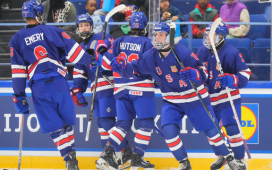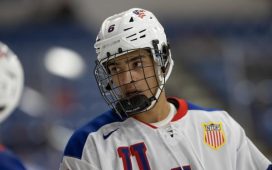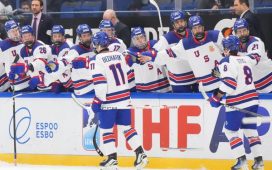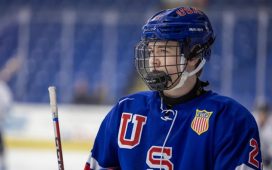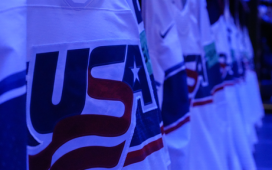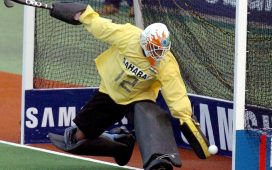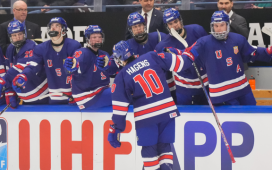It took a global pandemic for the NHL and NHL Players’ Association to be more in lockstep than they’ve ever been in their history. The result is labor peace for the next six years in an environment that is anything but stable.
As he addressed the media in a videoconference Saturday afternoon, NHL commissioner Gary Bettman was talking about all the work that has been accomplished by both the league and the NHL Players’ Association and what lies ahead of them. “To quote somebody famous, ‘This is not the beginning of the end, this is the end of the beginning,’ ” Bettman said. “I think that was Winston Churchill, by the way.”
“It was indeed,” replied NHLPA executive director Don Fehr to the amusement of both of them.
Remember the days when these two sides could barely stand to be in the same room with each other, virtual or otherwise? There was a time when the NHL and its players’ union would have taken opposing views on Newton’s laws of motion or whether chocolate remains the best flavor of ice cream, which it is. Now, 10 years after union firebrand Don Fehr, who once brought Major League Baseball owners to their knees, took over the NHLPA, the league and its union are in lockstep more than ever. Whether that’s a good or bad thing is open to debate. It’s certainly good for hockey fans who grow weary of labor issues being in the headlines. But those same fans will at one point lament that their teams will lose good players or miss out on signing other good players because there isn’t enough money under the cap to keep their teams together or make needed improvements.
But it’s not a stretch to suggest that the COVID-19 global pandemic brought these two sides together like never before. The four-year extension of the collective bargaining agreement that will guarantee labor peace in the NHL until at least 2026 was more of a meeting of the minds than a hammering out of give and take. Bettman called it, “an unprecedented collaboration and problem solving. I wouldn’t even say it approached a negotiation.”
That’s because it really wasn’t one. The global pandemic has played havoc with almost every industry in the world and hockey is no exception. The new CBA was always going to be tied into returning to play for the 2020-21 season and the NHLPA was faced with making the best of an epically unfortunate situation for them. The owners won this war a long time ago when they got cost certainty and a hard salary cap and ever since then, it has been more about losing as little ground as possible than gaining for the players. Toss in a global pandemic that has the potential to cut the revenues in half next season and the players never really stood a chance at making any systemic changes to the system that creates the escrow payments they claim to disdain so much. Now, instead of paying escrow on their salaries, there will be fewer dollars in the system with a flat salary cap, a reality that will become all too familiar to players looking for new contracts in the next couple of years. Players will be paying less and making less. Hardly a win for them.
“We’re living through difficult times, uncertain times…no one knows what the future would bring,” Fehr said. “And what that meant was that this wasn’t, and for all practical purposes could not be, normal collective bargaining. This is probably something that a lot of people are going to call a perfect agreement. A lot of people are going to find faults with one thing or another. And I’m pretty sure there’s going to be unanticipated events and unintended consequences. But I think this agreement meets the challenge.” Fehr went on to say later in the videoconference (channeling his inner Mike Babcock): “There’s obviously going to be some pain here. There’s obviously going to be reduced revenue. We tried to structure something that everybody could live with over time. But it’s important to understand that it’s over time. If revenue is less, revenue is less.”
So here we are, exactly three weeks before the puck drops to start the 2020 Stanley Cup tournament. There were a couple of interesting bits of information that leaked out in the video conference, which was also attended by deputy commissioner Bill Daly and Mathieu Schneider, the NHLPA’s special assistant to the executive director.
- The NHL is still intent on playing the 2020-21 season in its entirety, with a full 82-game schedule for each team and four rounds of the playoffs. “Looking at the schedule, making some adjustments, we believe we can play a full season,” Bettman said. “If we run a little later than usual, that may be one of the consequences. If we start in November or December (of 2021), so be it. We have the flexibility to do that.
- Things are still very fuzzy around what the threshold of positive tests would be to close the tournament down. The league would only say that it is relying on its medical experts for guidance. The return-to-play protocols allow for a stoppage if there is, “a material risk to player health and safety,” and an outbreak would, “jeopardize the integrity of the competition,” but that has never been quantified. Daly did say one positive test would not shut it down, but, “there are no hard and fast numbers.” Nor would the league say whether it would be willing to play out the tournament with fewer teams if any teams had to drop out, the way two teams have in the Major League Soccer tournament
- The pandemic basically means teams will not be giving out any injury information during a playoff, meaning if a player is out of the lineup, fans will have no idea whether it’s because he has sustained a hockey injury or has tested positive for COVID. The league will continue to release numbers of positive tests, but the identities of those who test positive will not be released. “We’ve talked to the NHLPA about it and continue to feel that medical privacy is important in this process.
- During the videoconference, media conferences scheduled for hub cities Edmonton and Toronto later in the day were postponed, but Bettman said there is no cause for alarm. “While we believe we’re buttoned-down at the provincial level in Ontario and Alberta, there are a couple of details we’re finalizing with the federal government…and we thought collectively it would be better to postpone the media avails that both hub cities and clubs were planning until those details are finalized.”
Want more in-depth features, analysis and an All-Access pass to the latest content? Subscribe to The Hockey News magazine.

